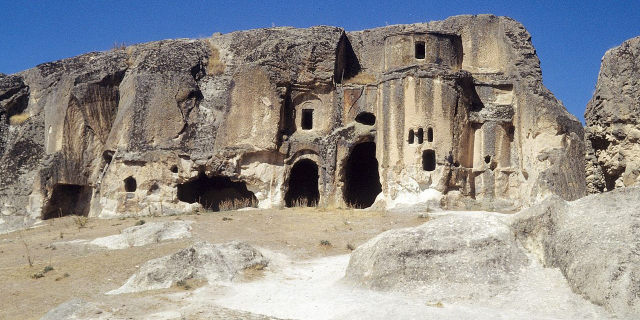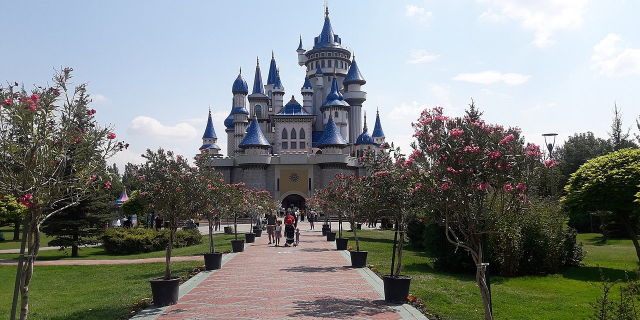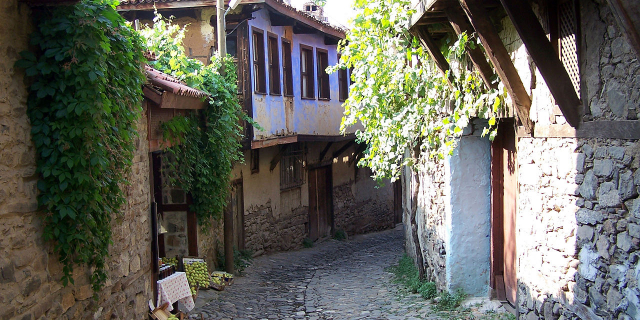Aizanoi (Ancient Greek: Αἰζανοί), Latinized as Aezani, was a Phrygian city in western Anatolia. It was located at the site of the modern village of Çavdarhisar, near Kütahya, on both sides of the Penkalas river, c. 1,000 m (3,300 ft) above sea level. The city was an important political and economic centre in Roman times; surviving remains from the period include a well-preserved Temple of Zeus, a combined theatre-stadium complex, and a round building, probably a macellum, inscribed with a copy of the Price Edict of Diocletian. The city fell into decline in Late Antiquity. In 2012 the site was submitted for inclusion on the UNESCO World Heritage List.
 Ruins of Aizanoi
Ruins of Aizanoi Map of ancient Aizanoi and the modern village of Çavdarhisar, c. 1835.
Map of ancient Aizanoi and the modern village of Çavdarhisar, c. 1835. Colonnaded street in Aizanoi
Colonnaded street in AizanoiSettlement in the area is known from the Bronze Age. The city may have derived its name from Azan, one of three sons of Arcas and the nymph Erato, legendary ancestors of the Phrygians.[1][2] During the Hellenistic period the city changed hands between the Kingdom of Pergamum and the Kingdom of Bithynia, before being bequeathed to Rome by the former in 133 BC. It continued to mint its own coins.[3] Its monumental buildings date from the early Empire to the 3rd century.
Aezani was part of the Roman province of Phrygia Pacatiana. It became a Christian bishopric at an early stage, and its bishop Pisticus (or Pistus) was a participant at the First Council of Nicaea, the first ecumenical council, in 325. Bishop Pelagius was at a synod that Patriarch John II of Constantinople hastily organized in 518 and that condemned Severus of Antioch; he was also at the Second Council of Constantinople in 553. Bishop Gregory was at the Trullan Council of 692, John at the Second Council of Nicaea in 787, and Theophanes at both the Council of Constantinople (869) and the Council of Constantinople (879).[4][5] The bishopric was at first a suffragan of Laodicea but, when Phrygia Pacatiana was divided into two provinces, it found itself a suffragan of Hierapolis, the capital of the new province of Phrygia Pacatiana II.[6][7] No longer a residential bishopric, Aezani is today listed by the Catholic Church as a titular see.[8]
After the 7th century, Aezani fell into decline. Later, in Seljuk times, the temple hill was converted into a citadel (Turkish: hisar) by Çavdar Tatars, after which the recent settlement of Çavdarhisar is named.[3][1][2] The ruins of Aezani/Aizanoi were noted by European travellers in 1824. Survey work in the 1830s and 1840s was followed by systematic excavation conducted by the German Archaeological Institute from 1926, resumed in 1970, and still ongoing.[3][1][2]
In January 2021, archaeologists led by Dr. Elif Özer from Pamukkale University announced that they had discovered a cache containing 651 Roman coins dated about 2,100 years ago in a jug buried near a stream. Researchers revealed a jug firstly in 2019. 439 pieces of coins were denarius (ancient Roman coins minted on silver), and 212 were cistophori, silver coins from Pergamum. Caesar, Brutus, Mark Antony and (young) Augustus are engraved on the mostly well-preserved coins. The find is going on display in the Museum of Anatolian Civilizations.[9][10][11][12]
In August 2021, archaeologists from Dumlupinar University announced the discovery of a statue of Hygieia. The human-sized statue is portrayed with a snake in its arms. The statue was revealed inside the columned gallery which runs throughout the south wing of the agora.[13][14]
In December 2021, archaeologists discovered a marble statue of Heracles.[15]





























Add new comment